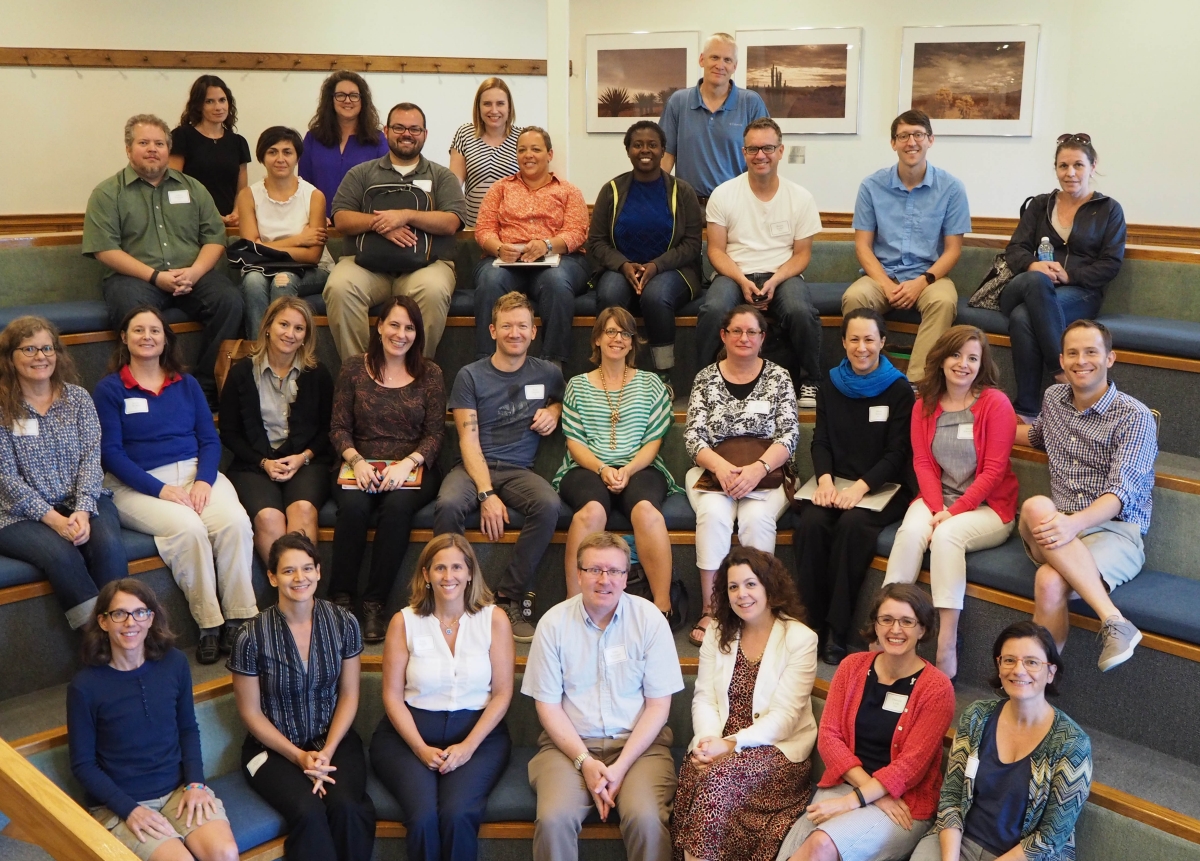
Participants of the Collaborative Humanities Redesign Project convened at the University of Missouri - Kansas City in September 2016.
Background and Overview
Despite overwhelming evidence supporting student-centered active learning over conventional lecture presentation, adoption of new methods has been slow across the board, including in the humanities. This project combined the resources of both large and small institutions—University of Kansas, Park University, Elon University, and Rockhurst University—to identify, further develop, and make widely visible many examples of excellent active and interactive instruction in the humanities. The project was organized through the Bay View Alliance, a consortium of seven research universities collaborating to increase the adoption of evidence-based and student-centered teaching.
The project was informed by a thoughtful body of research on the adoption of evidence-based pedagogy in undergraduate courses. This research suggests that academic leaders will most likely produce sustained change in teaching practices by providing resources and incentives for engagement with longer-term educational development activities that yield reflective teachers whose work is made visible to colleagues.
How It Worked
Each institution’s team included four to seven participating humanities faculty members (one designated as the leader) and one faculty development specialist to provide intellectual and logistical resources as well as local coordination of meetings. All participants met face-to-face once each year to build working groups across the institutions to provide feedback on instructional design and on evidence of student understanding in target courses. Participants maintained a reflective portfolio of course materials, including a syllabus, descriptions of learning activities in and outside of class, assignments, and samples of student work. Peers reviewed the course portfolios and engaged in virtual and face-to-face meetings to analyze and learn from each other’s experiences.
At the end of the first year, the participants had developed revised portfolios that described enhancements planned (or new courses developed) through the partnership and a benchmark sample of student work for evaluation at a later time. In the second year, the participants taught a transformed class, capturing samples of student performance and learning activities from both in and outside of class time. In the third year, participants delivered and expanded their redesigned courses, and updated their electronic course portfolios with examples, evidence, and reflection from their second offering of the flipped, active-learning course. At the end of the final year, the project leaders also hosted a conference inviting humanities faculty to learn about this three-year body of work, to review the portfolios, and to share their own teaching innovations
Results
Throughout the course of the project, the courses continued to become more interactive, and online activities increased to make more time during class periods to engage students in active learning. Wide variability existed in the degree of enhancements, with many participants engaging in deep and thoughtful redesign of the learning environment while some made more superficial changes. The best of the work shows the trajectory of improvement typical of reflective practice in higher education. Most participants did excellent work in redesigning assignments that could better capture meaningful understanding by students and by providing learning activities in class that were innovative and went beyond simply lecturing. About half of the participants were also innovative in the ways they provided feedback to students so they could subsequently revise their work in an iterative fashion, which was encouraging as many of the participants initially felt that students should get only one try on high stakes assessments. There was less adoption of innovative learning activities outside of class time, and only a handful developed or used interactive digital materials to supplement their conventional sources of reading and information.
Course Redesign Spotlight: Classics at Kansas
A team of three Classics professors at Kansas redesigned a series of assignments in a large-lecture-sized Classical Mythology course. The primary goal of the redesign was to deepen students’ ability to approach the material critically and responsibly. The faculty members set out to develop assignments that do not assume, but rather develop students’ critical thinking about Greek and Roman mythology, and to increase student engagement with the material. They experimented with several assignment formats—a three-part scaffolded writing assignment, a “virtual museum” project, and a set of analytical workshops.
Overall, the shift in achievement seemed to be strongest for students who started out with a weaker grasp of the targeted skills and knowledge. Remarkably, there has been a clear decrease in the D-grade-Fail-Withdrawal (DFW) rates since implementing the course redesign. In Fall 2015, the DFW rate was 41 percent (95/230 students) with a considerably high number of withdrawals. In 2016, the DFW rate lowered to 26 percent (67/272) with only 14 withdrawals. Since one early DFW bodes very ill for retention, this course redesign has the potential to make a real impact on the overall success of KU’s most vulnerable students. Average final scores rose by six percentage points, to 76 percent in fall 2014, compared to the prior year after the redesigned assignments were introduced. While there are several factors that might account for the improvement, it is apparent that introducing the scaffolded assignments and thus providing consistent opportunities to engage with the material beyond traditional quizzes and tests led to better retention of the course material, higher scores on exams, and higher rates of retention and completion in the course. The Kansas experience underlines how course redesign in the humanities can have an impact even in large enrollment courses.
In Conclusion
The collective work over the three years has reaffirmed that students are more engaged by active learning than they are by lectures (even good lectures), and learning is enhanced by using the interactivity afforded by online resources for team consideration of material. The humanities faculty involved in this project found that many more of their students were capable of advanced disciplinary habits of mind than they thought possible. The project provides good first steps toward changing the culture of humanities teaching at each of the four institutions.
Released September 08, 2017